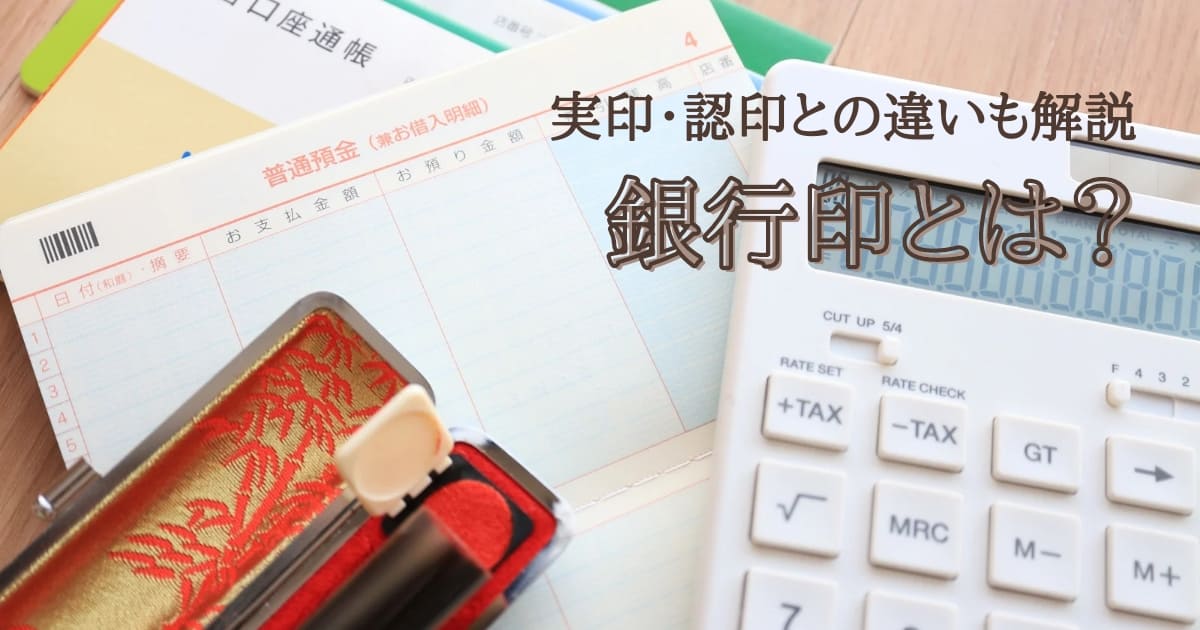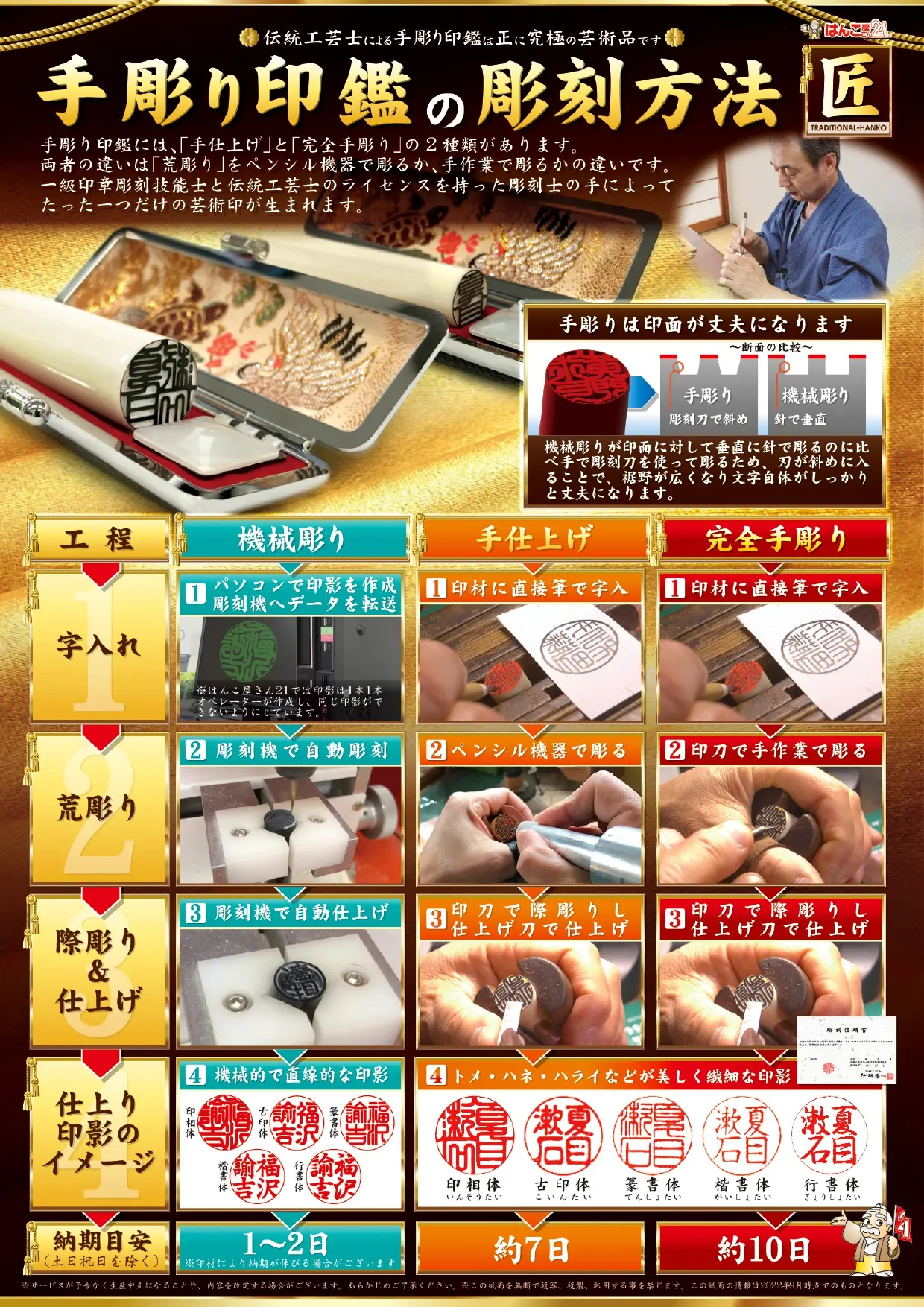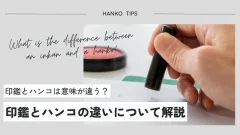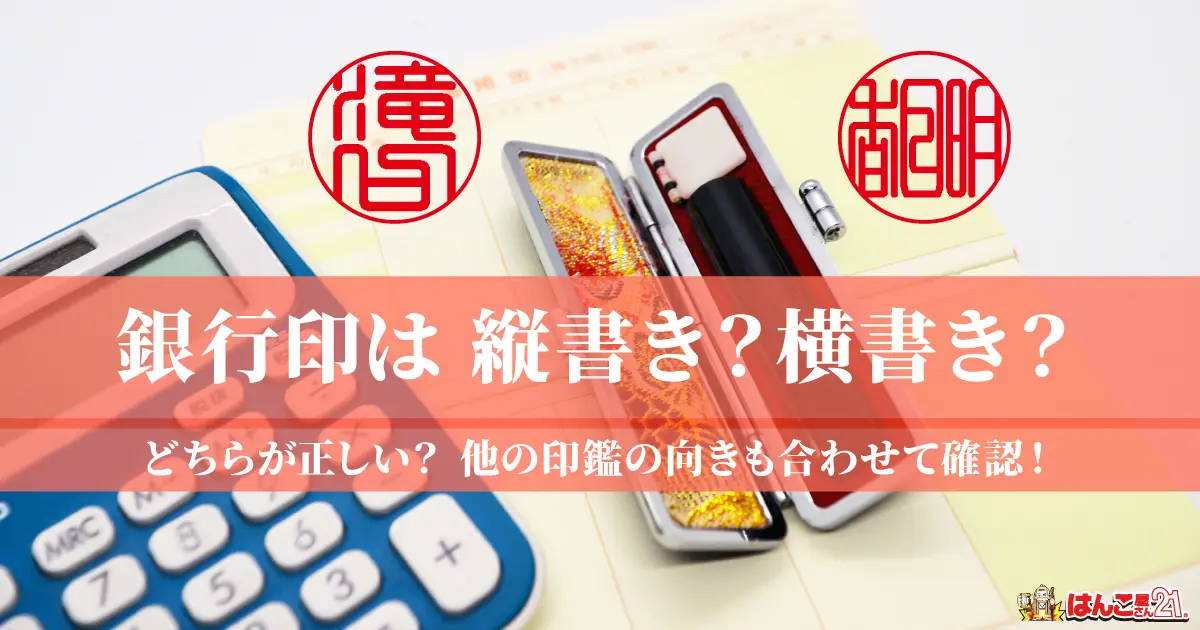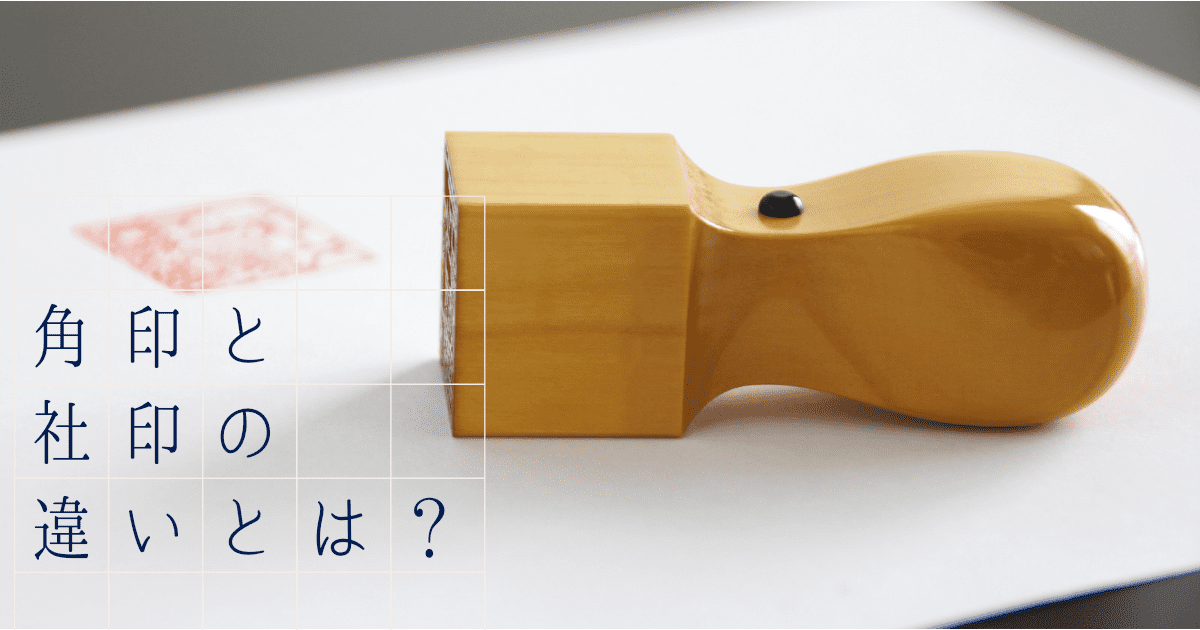Published on August 17, 2022
Added on July 27, 2023
You may be wondering, "What is a bank seal?" and "What standards should you follow to create one?"
A bank seal is a HANKO that is primarily used as identification when opening a bank account or changing registered information with a bank.
The most important HANKO used by an individual is the official seal registered with the government office, but the bank seal is the second most important HANKO after the official seal.
In this article, we will introduce an overview of bank seals and some points to consider when creating one.
There are almost no regulations regarding bank seals compared to registered seals, so it is possible to create a HANKO with a certain degree of freedom.
However, you need to be careful because if you create a design that is too elaborate, your bank may refuse to register.
The article also introduces points to consider when creating a bank seal, so please refer to it.
- What is a bank seal?
- Usage scenarios for bank seals
- How to register a bank seal
- Where to make a bank seal
- How to store bank seals
- Points to remember when making a bank seal
- Recommended engraving methods and stamp materials for bank seals (HANKO materials)
- Should bank seals be used differently for each bank?
- Frequently asked questions about bank seals
- Recommended bank seals and approximate purchase price
- summary
- Related article
What is a bank seal?
As the name suggests, a bank seal is a HANKO used for bank procedures. Bank seals are used not only by banks, but also by credit unions, credit unions, and credit card companies. You can think of it as being used to verify your identity in financial-related procedures. An increasing number of people use ATMs to withdraw cash and do other procedures online, but if you wish to withdraw a large amount of money that exceeds the ATM limit or need to handle other matters at a counter, you will need to bring your bank seal with you to complete the procedure. . Bank seals are necessary when dealing with your own property, so they are the second most important HANKO after a registered seal.
Difference from registered seal
HANKO used by individuals include bank seals, registered seals, and registered seals, but the registered seal is the most important HANKO. A registered HANKO is a HANKO that has been registered at a government office, and only one can be registered per person. Bank seals are also reliable HANKO that can be registered with financial institutions, but registered seals are used for more important contracts. Specifically, this includes sales contracts for houses and land, and automobile transaction contracts. Registration of a registered seal is limited to one per person, but in the case of bank seals, there is no problem in creating multiple HANKO and registering separate bank seals for each financial institution. It is also a little less important than a registered seal in that it allows multiple registrations. Although it is possible to use a registered seal as a bank seal and register it with multiple banks, it is not very desirable for crime prevention to use a registered seal frequently. Separate HANKO for each purpose and store them separately.
Difference from a registered seal
Compared to registered seals and bank seals, a personal seal is a HANKO that is used more on a daily basis. A personal seal is often used to signify approval or confirmation, such as when receiving packages or confirming the contents of employment contracts. The major difference between registered seals and bank seals is that there is no registration procedure. A registered seal must be registered at a government office, and a bank seal must be registered at a financial institution, but a registered seal can be used without being registered with either institution. For this reason, seals with common designs are mass-produced and can be easily purchased at 100 yen shops. Furthermore, you can design freely as there is no need to register. There are no regulations regarding the creation of a personal seal, so there is no problem with creating your own stamp with a nickname or illustration. Although it is possible to use a registered seal or a bank seal as a seal, it is better to create separate seals and store them in separate locations, including for security reasons.
Usage scenarios for bank seals
Let's take a look at the usage scenarios for bank seals. The main uses are as follows.
- Opening an account at a financial institution : Used for identity verification when opening an account
- Change of registered information of financial institution ...Used for HANKO when opening account
- Withdrawing cash : Used for identity verification at bank counters
- Utility bill payment : Used for verification with bank when debiting account
- Credit card creation : Used for bank verification when making a withdrawal from your account.
- Checks and drafts : When issuing a check, it is checked against the registration stamp of the current account.
It is used for registration with financial institutions and verification during procedures.
How to register a bank seal
Bank seals are registered at the financial institution where the account is opened.
The documents required to open an account at a financial institution are your ID and a bank seal you created in advance. Fill out the account opening application form and stamp the identity verification section with your bank seal.
The financial institution will then process your bank seal registration at the same time as opening your account.
Once registration is complete, you will be able to complete procedures using your bank seal, and you will be able to use it as a means of verification when making credit card withdrawals or utility bill deductions.
Where to make a bank seal
Regarding the bank seal to be registered, there are no detailed rules regarding the design etc. as it is sufficient for financial institutions to be able to verify and verify the identity of the person. However, if you register something with a general design that is sold at 100 yen shops, you will increase the risk of it being counterfeited.
We recommend purchasing at a store specializing in HANKO or online HANKO shopping sites. The reason is that bank seals with unique designs can be made to order using durable materials that can be used for decades.
How to store bank seals
A bank seal is a HANKO used when moving your own funds. Please manage your bank seals carefully to protect your valuable assets. You need to be especially careful when managing them to prevent them from getting lost or damaged. It is recommended that you store your most important registered seal in a separate location from the registered seal you use on a daily basis. This is because each has a different purpose and frequency of use. Naturally, the seals you use on a daily basis are frequently used, so they are often taken in and out of storage. Also, the most important registered seal has a wide range of uses, so you will probably use it regularly. Bank seals are not used as often because of online banking and ATMs, but there are times when you need to use them unexpectedly, such as when you need a little more money. If you store items that are used with different frequencies together, they may get lost when you put them in and take them out, so it's a good idea to store them separately.
Points to remember when making a bank seal
Here are some points to consider when creating a bank seal. First, let's check the regulations regarding bank seals.
regulations
The first point is the regulations regarding bank seals. There are no specific regulations regarding bank seals. However, according to the Japan Bankers Association, there are two regulations for registering bank seals.
<Bank seal regulations>
- Character items cannot be registered.
- HANKO made of easily deformable materials such as rubber stamps cannot be registered.
This is because if characters are engraved, many people may use the same HANKO, making verification difficult. Additionally, rubber stamps can become deformed over time or if used frequently. If it is deformed, verification will not be possible, so if it is recognized that there is a risk, registration will not be possible. In summary, if you use a material with excellent durability such as wood or titanium that has your name engraved on it, you can register it as a bank seal without any problems.
size
The second point is the size of the bank seal. There are no size regulations, so you can create a HANKO of any size you like. However, there are certain sizes that are easy to hold and stamp. Appropriate sizes are said to be 12mm, 13.5mm, and 15mm in diameter, starting from the smallest. For women, choose a 12mm to 13.5mm round bar, and for men, choose a 13.5mm to 15mm round bar to fit your hand more easily. Please note that the number of characters that can be engraved will vary depending on the size, so it is a good idea to consider the balance between the number of characters and ease of holding. A rough guideline is 3 characters for 12mm, 4 characters for 13mm, and 6 characters for 15mm.
Engraving
The third point is the engraved design of the bank seal. Choose engraving from full name, last name only, or first name only. There are no strict rules, so some people include illustrations. However, be careful not to design it so that the person's name cannot be confirmed. Depending on the bank, registration may be refused if the person's name cannot be determined from the seal. One way to create a design that will pass bank registration without any problems is to engrave it horizontally. You can customize the design a little, and you can clearly distinguish it from other HANKO. Also, some people choose horizontal writing to make it easier for money to accumulate so that money does not flow from top to bottom.
typeface
The last point is about the font of bank seals. There are four types of fonts used to engrave HANKO: Kointai, Reishotai, Tenshotai, and Insotai, which are easy to read. It is common to choose one or the other. Many people choose seal fonts and inso fonts as bank seal fonts because they are a little difficult to read and difficult to forge. Common and familiar typefaces include Kaisho font (Kai sho tai) and Gyo sho font (Gyosh sho tai), but the two listed on the left have thinner parts, so there is a possibility of chipping or damage with the slightest impact. , and is not highly recommended.
Recommended engraving methods and stamp materials for bank seals (HANKO materials)
Bank seals, which are used for opening accounts at financial institutions and depositing and withdrawing money, are the second most important seals after registered HANKO. For that reason, we recommend that you ask a HANKO specialist to make a HANKO that suits you rather than something that anyone can buy at a 100 yen shop. For that reason, it is important to know that there are machine carving and hand carving, and what materials are suitable.
hand carving and machine carving
There are two ways to engrave names and other information on stamp materials: hand engraving and machine engraving .
Hand engraving is when a person carves the letters on the seal by hand one by one. Therefore, it is difficult to engrave exactly the same thing, and its impression cannot be easily imitated. The carvings made by highly skilled first-class seal engravers are like works of art, and it is said that the beauty of the seal is reflected in the finish.
Machine engraving, on the other hand, uses an engraving machine to engrave a seal made on a PC. It is advantageous in that it has a shorter delivery time and lower cost than hand carving, but the carving quality is inevitably mechanical and uniform.
Hand carving allows you to have your own unique HANKO, but it takes time and money. Since machine engraving has a uniform engraving quality, it is easier to counterfeit than hand engraving, so please be careful when storing it. By the way, hand carving is said to be more durable.
Examples of materials suitable for bank seals
The Japan Bankers Association (General Incorporated Association) states that ``HANKO made of easily deformable materials such as rubber stamps cannot be registered.'' Materials suitable for bank seals must withstand long-term use, so materials that are durable to a certain extent include ivory, known as the "king of HANKO," titanium, which has become popular in recent years, and Dutch buffalo and black buffalo, which have been familiar for a long time. A high-quality HANKO is desirable. All of the above-mentioned stamp materials are highly durable and produce beautiful impressions, so they are often used not only for bank stamps but also for registered seals. Generally, ivory is the most expensive, and the price is different from titanium and buffalo.
Should bank seals be used differently for each bank?
Each person can only register one registered seal, but only one bank seal can be registered per account, so one person can create multiple bank seals and register different bank seals for each financial institution.
If you open accounts at multiple financial institutions using the same bank seal, you will only need one bank seal, so there will be no cost or hassle. However, if the bank seal is stolen, all accounts are at risk.
One way to diversify your risk is to use different bank seals for each bank. In that case, you will need to know which bank stamp was used for which passbook.
Frequently asked questions about bank seals
A frequently asked question is "Is it possible to have a bank seal with only the name on it?" Bank seals can be engraved with either a ``full name'', ``surname only'', or ``name only'', but please be aware that if the design uses illustrations etc. and the name is difficult to confirm, registration may not be possible.
I am also often asked, "Can the registered seal and bank seal be the same?" Although it is possible to register a registered seal as a bank seal, a registered seal is rarely used except for very important contracts. Store it in a safe place, separate from the bank seal.
Recommended bank seals and approximate purchase price
The fee for creating a bank seal varies depending on the material used for the HANKO. Basically, they are all made of strong materials that do not deteriorate over time and feel heavy when you hold them. Recently, there has been an increase in the number of titanium materials used to make HANKO that are strong, lightweight, and easy to hold.
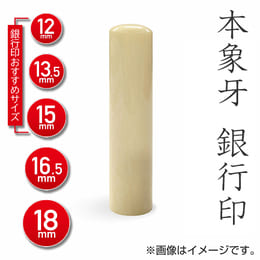
Genuine ivory
Starting from 14,740 yen
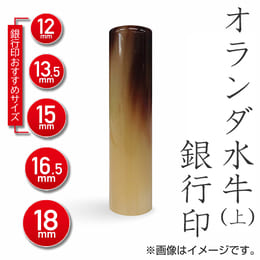
dutch buffalo
Starting from 7,370 yen
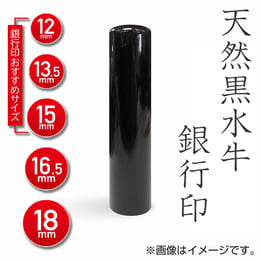
natural black buffalo
Starting from 7,920 yen
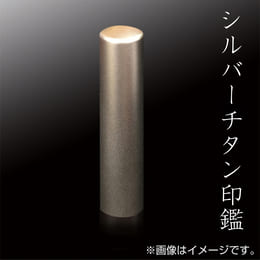
titanium HANKO
From 8,800 yen
summary
A summary of bank seals.
- A bank seal is a HANKO used for procedures at financial institutions.
- Register when opening an account at a financial institution
- Since there are no strict regulations, it is possible to design a seal that is easy to distinguish from other HANKO.
A bank seal is also a HANKO for managing one's own property. Although there are no detailed rules for creating one, it is best to avoid using commercially available ones as is to prevent counterfeiting.
Related article
 日本語
日本語 English
English 简体中文
简体中文 繁體中文
繁體中文 한국어
한국어 ไทย
ไทย Tiếng Việt
Tiếng Việt Indonesia
Indonesia Français
Français Español
Español Português
Português
